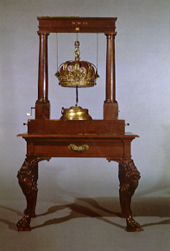
96.5 x 44.3 x 78
Lodestone, iron, wood and ivory
INDEX 1788 : M.IV. d43
Magnes Sinicus figurae irregularis eleganter armatus. Lapis nudus est 512 unciarum pondo, ac pondus 2880. unciarum usque sustulit. Sustinetur Magnes a Basi lignea, cui insistunt columnae binae cum epystilo, et ope manubrii per trochleas occultas, ac funiculos columnis et epystilo interclusos, tenditur atque laxatur.
A magnet from China, irregular in shape and in an ornate setting. The stone weighs 512 ounces and raises a weight of up to 2880 ounces. The magnet is supported on a wooden base between two columns with an epistyle. A handle controls concealed pulleys and strings inside the columns and epistyle to raise and lower the magnet.
This fine piece consists of an unusually large block of lodestone weighing 12 kg. Its precise origin is unknown, although tradition says that it came from China as a gift from the Emperor to King João V of Portugal. The stone is housed in a royal crown of golden metal. The whole is suspended by means of a rope from a horizontal wooden beam supported on two vertical columns. The beam and columns are hollow and contain a system of pulleys to raise and lower the crown, by means of a handle near the bottom of one of the columns. Each of the columns has a mechanism of toothed wheels to facilitate this operation; removal of a small panel gives access to them.
Apart from the rope that holds the royal crown by its ring, there are two other, thinner ropes attached by rings to two diametrically opposed buttons in the band of the crown. While the crown is hanging by the central rope, it is the right way up. If it is held by the lateral ropes it is inverted, revealing a steel disc on its upper side. The disc has two steel projections which represent the poles. In this position the magnet can be used in experiments and can magnetise compass needles.
When the royal crown is in its normal position, a metal triangular component, with a ring to suspend heavy bodies, is placed on its underside, attracted by the magnet's poles.
To measure the breaking force of the magnet, progressively heavier bodies are suspended from it until the greatest weight that it can hold is reached.
Regarding this maximum weight, the two catalogues published by dalla Bella have different information. The Index Instrumentorum of 1788 says 83.520 kg, but the 1790 inventory mentions 94.859 kg.
There is an 18th century engraving, signed by Inácio de Oliveira, showing the magnet installed in its original setting, before the Gabinete. This illustration shows that the original setting displays an armillary sphere on the horizontal beam supporting the crown. The whereabouts of this sphere is not known.
The table on which the whole assemblage stands is probably the one illustrated in the engraving referred to above.
Examination of the engraving enables us to see that a quadrupod formed part of the instrument. This was to catch the metal triangle once the weight of the suspended body exceeded the breaking force, so that the body would not fall directly on the table. The quadrupod was placed over a cushion, beneath was a copper spring to absorb the shock of the impact. The cushion and the spring still exist.
Rómulo de Carvalho says, in his História do Gabinete de Física da Universidade de Coimbra, that, according to the inscription on the engraving referred to above, this magnet was assembled in Lisbon by William Dugood, member of the Royal Society, who was living in Portugal at that time.
From Colégio dos Nobres, catalogue n.º 40.Carvalho, Rómulo de, História do Gabinete de Física da Universidade de Coimbra, Universidade de Coimbra, Biblioteca Geral, Coimbra, 1978, pp. 176-182.